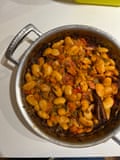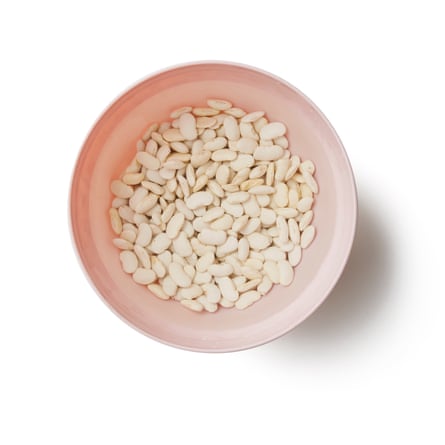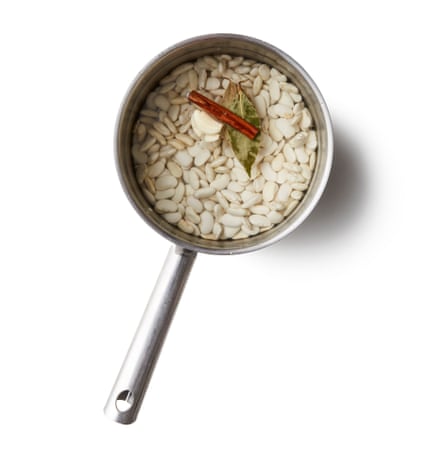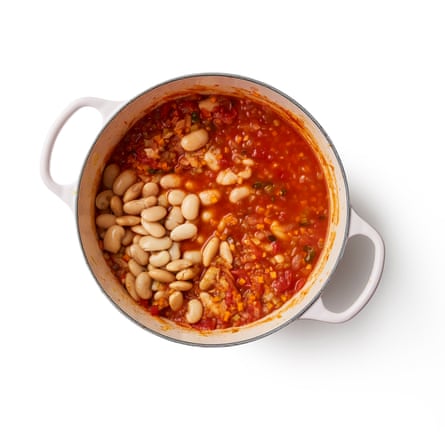Gigantes plaki, or (very) big baked beans, occupy a similarly beloved place in the Greek heart to our own baked beans. However, though they are also available in tins, they’re rather more likely to be made from scratch. They pop up on restaurant menus as well as at home, both as a warm stew – which, because it’s vegan, is particularly popular during Lent – and served at room temperature as part of a meze selection.
Unsurprisingly, few Greek cookbooks are without their own version: Rena Salaman sells her gigantes plaki as “a sensational dish, splendidly vegetarian, luxuriously rich”, whileGeorgina Hayden calls the dish an “absolute classic” in her book Taverna and Christos Sourligas admits he “can eat bowlfuls” of the stuff (me, too, after this week). Given that we should all be consuming more fibre-packed beans and pulses, this is a recipe well worth adding to your repertoire, too.

The beans
In her book The Foods of Greece, Aglaia Kremezi writes that, “Gigantes, which means ‘extremely large’ in Greek, is what the Greeks call the very large lima beans used for this dish”. (British readers currently feeling little the wiser should note that lima beans, or Phaseolus lunatus, are known here as butter beans.) Jenny Chandler explains in Pulse, her excellent guide to all things leguminous, that this is “a bean apart from all the other Latino beans, not just because of its size and creamy texture, but also because of its Andean origins. It is from a quite different family from all the kidney and haricot beans, and many would say a more aristocratic bean altogether.”
Gigantes are not just any butter beans, either.Carolina Doriti tells readers of her book Salt of the Earth that they are “mostly grown in [Greece’s] northwest region, famously in Prespes and Kastoria, both stunning lake regions with a PGI [Protected Geographic Indication] for giant beans.” Greek-produced examples are readily available online and in specialist shops, and seem to be both larger and creamier than standard dried butter beans; whether that’s thanks to their origins or simply because they’re fresher than a bog-standard butter bean (the UK not being a great consumer of the things) is hard to tell, though. If you can get hold of gigantes, they’re the best bet, but dried butter beans will make a very satisfactory substitute.
Soaking, a step once mandatory with dried pulses, seems to have gone out fashion in recent years: as Joe Yonan, food editor of the Washington Post, writes in his book Cool Beans, “soaking is certainly not a requirement: just ask millions of cooks in Mexico (a bean-loving country if ever there was one) who never have, never will”. I would advise it here though, first because it’s a guaranteed way to speed up the cooking time with beans of an indeterminate age, and second because soaking them in brine, as chef Akis Petretzikis suggests, both softens the skin – in defiance of the old wisdom that claimed the opposite – and infuses them with flavour. (Belinda Harley, author of Roast Lamb in the Olive Groves, soaks hers with bicarbonate of soda, but I can always detect a slight soapiness in the finished dish.)

Recipes take different approaches to cooking the beans, too, from boiling them for a mere five minutes before baking (Sourligas, who with his late mother Evdokia Antginas co-authored My Big Fat Greek Cookbook), boiling them for 20 minutes then leaving them to sit for an hour before baking (Harley), and boiling them for 40-60 minutes until tender (Doriti, Petretzikis, Hayden). If you want to go down the five-minute route, you’ll need to shell the beans first, which I think gives the dish a slightly different quality – more elegant, because the beans cook more quickly and so retain their shape better, but less deliciously starchy. I prefer Hayden’s method, which involves peeling just a handful of the beans, so they break down to thicken the sauce during her longer cooking time, but leaving the rest intact. Peeled or unpeeled, however, it seems wise to make sure the beans are tender before moving on to the next stage, which means cooking them for as long as it takes (which largely depends on the age and condition of your beans).
In the interests of making life easier wherever possible, I try Rosemary Barron’s recipe from Flavours of Greece using tinned butter beans, rather than dried, and can report that they’re certainly a viable option if you’re in a hurry; the beans absorb less of the flavour of the sauce, however, and the dish feels more like an assembly job. A decent one, but you do sacrifice something to convenience.
The sauce
With the exception of Antginas and Sourligas, who simply bake the beans with oil and tomato juice before adding oregano at the end, most recipes involve a more complex sauce. Onions (red ones, in Hayden’s case), carrots, celery and garlic usually form the base, with Harley and Petretzikis also including celery leaves, and the latter red pepper, which is useful if you’d like to up the vegetable content, though I think you can taste the beans better without it. Hayden and Petretzikis both keep most of the vegetables fairly chunky, so they keep their shape in the finished dish. Again, it’s up to you, but I like the way they melt into the sauce when finely chopped, so that’s what I’ve suggested below.
Tomatoes are a must in this take on the dish (which is not the only one: Doriti also supplies a delicious-looking green gigantes involving spinach and chard). Tomato juice alone proves too thin a base for my tastes, but either fresh tomatoes, as in Barron and Harley’s recipes, or tinned, as used by everyone else, will yield a more satisfying consistency. In an effort to keep the beans themselves front and centre, I’ve skipped the tomato puree, but added a little of the cooking liquid from the beans, an idea I get from Hayden, not least because, as Yonan puts it, that earthy, bean-infused water is “liquid gold” to the cook. If you yearn for a richer, more refined take, you might prefer, like Petretzikis, to use white wine and vegetable (or chicken) stock instead, but, to me, that’s over-egging the pudding. And, because I’ll be using the cooking water for my sauce, I’ll be boiling the beans with the cinnamon stick Hayden tucks into her baking dish, plus a couple of bay leaves and some extra garlic, to give it, and the beans themselves, as much flavour as possible.
Oregano (particularlyrigani, the Greek variety, which Barron informs her readers is a “stronger, sharper version of the familiar imported Italian herb”, and sold by Greek specialists) always feels to me like the perfume of Greece, so I’ve added some of that here, though thyme is equally popular in the recipes I try, with Petretzikis also using rosemary, dill and parsley, plus a pinch of chilli (celebrity chefs, eh?).
Finally, a spoonful of Barron’s honey (though Salaman and Petretzikis add sugar) and a dash of Harley’s red-wine vinegar (or, as Barron suggests, some lemon juice to finish) brings out the sweet-and-sour notes of the tomatoes and lifts the starchy flavour of the beans.
The baking

Bake the beans covered initially, and at a moderate heat, so they can finish cooking and mingle with the sauce before they’re finally exposed to direct heat to crisp up on top, which is what gives this dish its characteristic mix of textures and tastes. Without this step, it’s a bean stew, and may as well be cooked entirely on the stove-top, as in Harley’s recipe.
The garnish
If you’re a fan of parsley, you can use it to add some colour (or, indeed, dill, though I found it fought with the oregano). A sprinkling of Petretzikis’s crumbled feta, lemon zest or chilli flakes will also please the eye, but for the palate, I’d recommend topping it with nothing more complicated than a dash more olive oil. A simple garnish for a simple dish.
Serve warm, or at room temperature, rather than hot, and with plenty of bread.
Perfect gigantes
Prep 15 min
Soak 8 hr+
Cook 1 hr 50 min
Serves 4
500g dried gigantes or butter beans
1⅓ tbsp flaky salt, plus extra to serve
2 bay leaves
1 cinnamon stick
2 garlic cloves, peeled
50ml extra-virgin olive oil, plus more to serve
1 large onion, peeled and finely chopped
2 celery sticks, trimmed and finely chopped
2 medium carrots, trimmed and finely chopped
2 tsp oregano
2 tbsp red-wine vinegar
2 tsp honey
1 x 400g tin chopped tomatoes, or 4 plum tomatoes, chopped

Put the beans in a bowl and add cold water to cover them by about 5cm. Add a tablespoon of flaky salt, stir well to dissolve, then leave to soak for eight to 12 hours.

Drain the beans and put all but a small handful (favour any whose skins have already started to split) into a large saucepan. Cover with 5cm fresh water, add another teaspoon of flaky salt, the bay leaves, cinnamon stick and one of the garlic cloves, peeled and squashed with the back of a knife, and bring to a boil.
Meanwhile, peel the handful of reserved beans, then add these to the pan and boil hard for 10 minutes. Turn down the heat and leave to simmer gently until just tender, and probably 45 minutes to an hour.

While the beans are cooking, pour the oil into an ovenproof dish for which you have a lid and set it over a gentle heat. Add the onion, celery and carrot, and fry, stirring occasionally, until soft and golden. Peel and crush or finely chop the remaining garlic clove, add this to the fried vegetable mix, along with the oregano, and fry for another minute.

Stir in the vinegar, honey and tomatoes, bring to a boil, then turn down the heat and simmer for five minutes. Heat the oven to 180C/160C fan/gas 4.

Drain the beans, reserving their cooking liquid, then stir about 300ml of the bean water into the sauce dish. Stir in the beans and aromatics, bring everything to a boil, cover and transfer to the oven for 40 minutes.

Take off the lid and put the dish back in the oven for a final 15 minutes, stirring in a little more of the cooking water first if the beans look a little dry. Leave to cool to warm, then check the seasoning, adjusting if necessary. Drizzle with a little more olive oil and serve.
-
Gigantes plaki: are you a fellow fan of this Greek classic and, if so, do you prefer them with tomatoes, or is there another version you’d recommend? And which other bean dishes should I try in my efforts to incorporate more pulses into my diet?
"food recipes" - Google News
July 26, 2023 at 05:00PM
https://ift.tt/UOBATgD
How to make the perfect gigantes plaki – recipe - The Guardian
"food recipes" - Google News
https://ift.tt/mOxboV3
https://ift.tt/17ks2Cm
Bagikan Berita Ini















0 Response to "How to make the perfect gigantes plaki – recipe - The Guardian"
Post a Comment